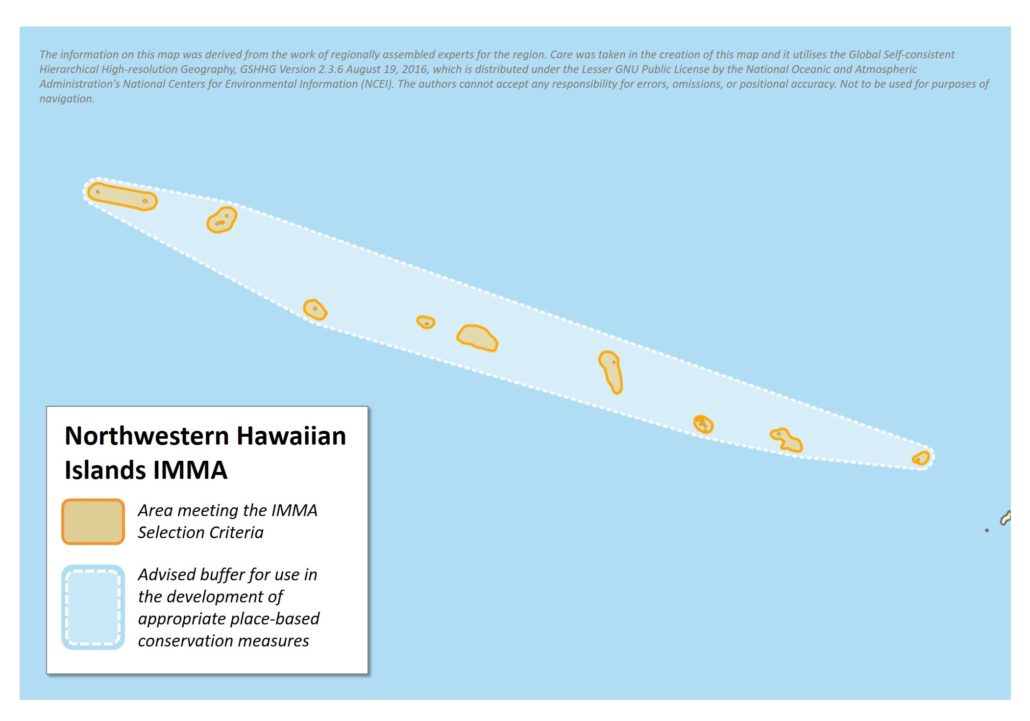Size in Square Kilometres
17,213
Qualifying Species and Criteria
Hawaiian Monk Seal – Neomonachus schauinslandi
Criterion A; C (1)
Spinner Dolphin – Stenella longirostris
Criterion B (1)
Criterion D (2) – Marine Mammal Diversity
Other Marine Mammal Species Documented
Feresa attenuata, Globicephala macrorhynchus, Kogia sima, Megaptera novaeangliae, Mesoplodon densirostris, Peponocephala electra, Pseudorca crassidens, Stenella attenuata, Steno bredanensis, Tursiops truncatus, Ziphius cavirostris
Summary
The area holds a significant proportion of the global population of the Endangered Hawaiian monk seal (Neomonachus schauinslandi). It encompasses 10 discrete areas of critical habitat designated for the Hawaiian monk seal in the Northwestern Hawaiian Islands (NWHI) under the U.S. Endangered Species Act. These include Kure Atoll, Midway Atoll, Pearl and Hermes Reef, Lisianski Island, Laysan Island, Maro Reef, Gardner Pinnacles, the French Frigate Shoals, Necker Island, and Nihoa Island. These areas include the preferred pupping and nursing areas, significant haul-out areas, and/or marine foraging areas that are essential for the persistence of the species. In addition, the areas furthest west around Kure Atoll and Midway Atoll, and Pearl and Hermes Reef support two small and resident populations of spinner dolphins (Stenella longirostris). These two areas are recognised as Biologically Important Areas (BIAs) by the U.S.
Description of Qualifying Criteria
Criterion A – Species or Population Vulnerability
The Hawaiian monk seal (Neomonachus schauinslandi) is listed as Endangered (EN C1) on the IUCN Red List of Threatened Species (Littnan et al. 2015). According to the current IUCN Red List account within the Monk Seal’s range, two regions are often distinguished: The Northwest Hawaiian Islands (NWHI), comprising eight subpopulations located on remote atolls and small islands, and the Main Hawaiian Islands, comprising eight large high islands and associated small islets (Littnan et al. 2015). The NWHI IMMA supports most of the remaining Hawaiian monk seals; approximately 1100 of the approximately 1400 estimated in 2016.
Criterion B – Distribution and Abundance
Sub-criterion B1 – Small and Resident Populations
Evidence suggests that there are five demographically isolated populations of spinner dolphins (Stenella longirostris) throughout the Hawaiian archipelago (Andrews et al., 2010; Figure 5.9; Table S5.9). These include populations recently been recognized as distinct stocks by NOAA Fisheries (Carretta et al., 2014) and include two populations across the Kure and Midway Atolls, and the Pearl and Hermes Reef. These are recognised as being Biologically Important Areas (BIAs) for spinner dolphins by the U.S. (Baird et al., 2015).
Sub-criterion B2 – Aggregations
Criterion C: Key Life Cycle Activities
Sub-criterion C1 – Reproductive Areas
The IMMA comprises critically important breeding habitats for the Endangered Hawaiian monk seal, including key areas for pupping and pup care (Littnan et al. 2015). Their six main reproductive sites are in the Northwestern Hawaiian Islands (NWHI) at Kure Atoll, Midway Atoll, Pearl and Hermes Reef, Lisianski Island, Laysan Island, and French Frigate Shoals (National Marine Fisheries Service 2007). Pups are born throughout the year, with the largest numbers of nursing pairs present April – August. Mothers rely on beach areas to nurse their pups for approximately 40 days. After weaning, pups remain in shallow near-shore areas for several weeks before developing broader and deeper foraging areas.
Sub-criterion C2: Feeding Areas
Sub-criterion C3: Migration Routes
C3a – Whale Seasonal Migratory Route
C3b – Migration / Movement Area
Criterion D – Special Attributes
Sub-criterion D1 – Distinctiveness
Sub-criterion D2 – Diversity
Supporting Information
50 CFR 226. 2015. Endangered and Threatened Species: Final Rulemaking To Revise Critical Habitat for Hawaiian Monk Seals, pp: 50925-50988
Baird, R. W., Cholewiak, D., Webster, D. L., Schorr, G. S., Mahaffy, S. D., Curtice, C., . . . Van Parijs, S. M. 2015. 5 – Biologically Important Areas for cetaceans within U.S. waters – Hawai’i region. In S. M. Van Parijs, C. Curtice, and M. C. Ferguson (Eds.), Biologically Important Areas for cetaceans within U.S. waters (pp. 54-64). Aquatic Mammals (Special Issue), 41(1). 128 pp.
Baker, J. D. and Johanos, T. C. 2004. Abundance of the Hawaiian monk seal in the main Hawaiian Islands. Biological Conservation 116: 103-110.
Littnan, C., Harting, A. and Baker, J. 2015. Neomonachus schauinslandi. The IUCN Red List of Threatened Species 2015: e.T13654A45227978. http://dx.doi.org/10.2305/IUCN.UK.2015-2.RLTS.T13654A45227978.en. Downloaded on 28 March 2017.
National Marine Fisheries Service. 2014. Revision of Critical Habitat for Hawaiian Monk Seals. Final Biological Report. Honolulu, HI, USA. Available at: http://www.fpir.noaa.gov/Library/PRD/Hawaiian%20monk%20seal/Hawaiian_monk_seal_Biological_Report_for_Critical_Habitat.pdf
National Marine Fisheries Service. 2007. Recovery Plan for the Hawaiian Monk Seal. Honolulu, HI, USA. Available at: http://www.nmfs.noaa.gov/pr/pdfs/recovery/hawaiianmonkseal.pdf.
Downloads
Download the full account of the Northwestern Hawaiian Islands using the Brochure button below:
To make a request to download the GIS Layer (shapefile and/or geojson) for the Northwestern Hawaiian Islands please complete the following Contact Form:



